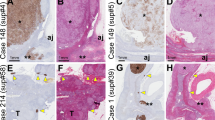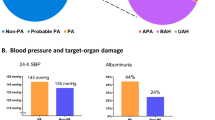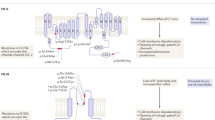Abstract
Primary aldosteronism is caused by bilateral idiopathic hyperplasia in approximately two-thirds of cases and aldosterone-producing adenoma in one-third. Most patients with primary aldosteronism are normokalemic. In the clinical setting of normokalemic hypertension, patients who have resistant hypertension and hypertensive patients with a family history atypical for polygenic hypertension should be tested for primary aldosteronism. The ratio of plasma aldosterone concentration to plasma renin activity has been generally accepted as a first-line case-finding test. If a patient has an increased ratio, autonomous aldosterone production must be confirmed with an aldosterone suppression test. Once primary aldosteronism is confirmed, the subtype needs to be determined to guide treatment. The initial test in subtype evaluation is CT imaging of the adrenal glands. If surgical treatment is considered, adrenal vein sampling is the most accurate method for distinguishing between unilateral and bilateral adrenal aldosterone production. Optimal treatment for aldosterone-producing adenoma or unilateral hyperplasia is unilateral laparoscopic adrenalectomy. The idiopathic bilateral hyperplasia and glucocorticoid-remediable aldosteronism subtypes should be treated pharmacologically. All patients treated pharmacologically should receive a mineralocorticoid receptor antagonist, a drug type that has been shown to block the toxic effects of aldosterone on nonepithelial tissues.
Key Points
-
Primary aldosteronism is present in 5–13% of people with hypertension
-
Diagnosis of primary aldosteronism is based on an increased ratio of plasma aldosterone concentration to plasma renin activity, and results of a subsequent aldosterone suppression test
-
There are several subtypes of primary aldosteronism—bilateral idiopathic hyperplasia and aldosterone-producing adenoma are the most common
-
Determination of subtype is essential to direct therapy
-
Surgical (e.g. laparoscopic adrenalectomy) and pharmacological (e.g. mineralocorticoid receptor antagonists) interventions are commonly used
This is a preview of subscription content, access via your institution
Access options
Subscribe to this journal
Receive 12 print issues and online access
$209.00 per year
only $17.42 per issue
Buy this article
- Purchase on Springer Link
- Instant access to full article PDF
Prices may be subject to local taxes which are calculated during checkout



Similar content being viewed by others
References
Hajjar I and Kotchen TA (2003) Trends in prevalence, awareness, treatment, and control of hypertension in the United States, 1988–2000. JAMA 290: 199–206
Conn JW (1955) Presidental address: part I painting background; part II primary aldosteronism, a new clinical syndrome. J Lab Clin Med 45: 3–17
Conn JW and Conn ES (1961) Primary aldosteronism versus hypertensive disease with secondary aldosteronism. Recent Prog Horm Res 17: 389–414
Conn JW (1966) The evolution of primary aldosteronism: 1954–1967. Harvey Lect 62: 257–291
Andersen GS et al. (1988) The incidence rate of phaeochromocytoma and Conn's syndrome in Denmark, 1977–1981. J Hum Hypertens 2: 187–189
Berglund G et al. (1976) Prevalence of primary and secondary hypertension: studies in a random population sample. Br Med J 2: 554–556
Fishman LM et al. (1968) Incidence of primary aldosteronism uncomplicated “essential” hypertension: a prospective study with elevated aldosterone secretion and suppressed plasma renin activity used as diagnostic criteria. JAMA 205: 497–502
Streeten DH et al. (1979) Reliability of screening methods for the diagnosis of primary aldosteronism. Am J Med 67: 403–413
Tucker RM and Labarthe DR (1977) Frequency of surgical treatment for hypertension in adults at the Mayo Clinic from 1973 through 1975. Mayo Clin Proc 52: 549–545
Kaplan NM (1967) Hypokalemia in the hypertensive patient, with observations on the incidence of primary aldosteronism. Ann Intern Med 66: 1079–1090
Dunn PJ and Espiner EA (1976) Outpatient screening tests for primary aldosteronism. Aust NZ J Med 6: 131–135
Hiramatsu K et al. (1981) A screening test to identify aldosterone-producing adenoma by measuring plasma renin activity: results in hypertensive patients. Arch Intern Med 141: 1589–1593
Mulatero P et al. (2004) Increased diagnosis of primary aldosteronism, including surgically correctable forms, in centers from five continents. J Clin Endocrinol Metab 89: 1045–1050
Mosso L et al. (2003) Primary aldosteronism and hypertensive disease. Hypertension 42: 161–165
Gordon RD et al. (1994) High incidence of primary aldosteronism in 199 patients referred with hypertension. Clin Exp Pharmacol Physiol 21: 315–318
Loh KC et al. (2000) Prevalence of primary aldosteronism among Asian hypertensive patients in Singapore. J Clin Endocrinol Metab 85: 2854–2859
Fardella CE et al. (2000) Primary hyperaldosteronism in essential hypertensives: prevalence, biochemical profile, and molecular biology. J Clin Endocrinol Metab 85: 1863–1867
Lim PO et al. (2000) High prevalence of primary aldosteronism in the Tayside hypertension clinic population. J Hum Hypertens 14: 311–315
Schwartz GL and Turner ST (2005) Screening for primary aldosteronism in essential hypertension: diagnostic accuracy of the ratio of plasma aldosterone concentration to plasma renin activity. Clin Chem 51: 386–394
Hamlet SM et al. (1985) Is aldosterone/renin ratio useful to screen a hypertensive population for primary aldosteronism? Clin Exp Pharmacol Physiol 12: 249–252
Calhoun DA et al. (2002) Hyperaldosteronism among black and white subjects with resistant hypertension. Hypertension 40: 892–896
Gallay BJ et al. (2001) Screening for primary aldosteronism without discontinuing hypertensive medications: plasma aldosterone–renin ratio. Am J Kidney Dis 37: 699–705
Pratt JH et al. (1999) Levels of mineralocorticoids in whites and blacks. Hypertension 34: 315–319
Rayner BL et al. (2001) Screening for primary aldosteronism—normal ranges for aldosterone and renin in three South African population groups. S Afr Med J 91: 594–599
Conn JW et al. (1965) Normokalemic primary aldosteronism: a detectable cause of curable “essential” hypertension. JAMA 193: 200–206
Mulatero P et al. (2002) Drug effects on aldosterone/plasma renin activity ratio in primary aldosteronism. Hypertension 40: 897–902
Rossi E et al. (2002) High prevalence of primary aldosteronism using postcaptopril plasma aldosterone to renin ratio as a screening test among Italian hypertensives. Am J Hypertens 15: 896–902
Brown NJ (2005) Aldosterone and end-organ damage. Curr Opin Nephrol Hypertens 14: 235–241
Brilla CG et al. (1990) Remodeling of the rat right and left ventricles in experimental hypertension. Circ Res 67: 1355–1364
Rocha R et al. (2002) Aldosterone induces a vascular inflammatory phenotype in the rat heart. Am J Physiol Heart Circ Physiol 283: H1802–1810
Takeda Y et al. (2001) Effects of high sodium intake on cardiovascular aldosterone synthesis in stroke-prone spontaneously hypertensive rats. J Hypertens 19: 635–639
Kozakova M et al. (2003) Myocardial ultrasonic backscatter in hypertension: relation to aldosterone and endothelin. Hypertension 41: 230–236
Stowasser M et al. (2005) Evidence for abnormal left ventricular structure and function in normotensive individuals with familial hyperaldosteronism type I. J Clin Endocrinol Metab 90: 5070–5076
Milliez P et al. (2005) Evidence for an increased rate of cardiovascular events in patients with primary aldosteronism. J Am Coll Cardiol 45: 1243–1248
Pitt B et al. (2003) Eplerenone, a selective aldosterone blocker, in patients with left ventricular dysfunction after myocardial infarction. N Engl J Med 348: 1309–1321
Zannad F et al. (2000) Limitation of excessive extracellular matrix turnover may contribute to survival benefit of spironolactone therapy in patients with congestive heart failure: insights from the Randomized Aldactone Evaluation Study (RALES). Circulation 102: 2700–2706
Fallo F et al. (2006) Prevalence and characteristics of the metabolic syndrome in primary aldosteronism. J Clin Endocrinol Metab 91: 454–459
Chhokar VS et al. (2005) Hyperparathyroidism and the calcium paradox of aldosteronism. Circulation 111: 871–878
Young WF Jr (2003) Minireview: primary aldosteronism—changing concepts in diagnosis and treatment. Endocrinology 144: 2208–2213
Blumenfeld JD et al. (1994) Diagnosis and treatment of primary hyperaldosteronism. Ann Intern Med 121: 877–885
Mansoor GA et al. (2002) Unilateral adrenal hyperplasia causing primary aldosteronism: limitations of I-131 norcholesterol scanning. Am J Hypertens 15: 459–464
Seccia TM et al. (2005) Aldosterone-producing adrenocortical carcinoma: an unusual cause of Conn's syndrome with an ominous clinical course. Endocr Relat Cancer 12: 149–159
Mulatero P et al. (2004) Genetics of primary aldosteronism. J Hypertens 22: 663–670
So A et al. (2005) Familial hyperaldosteronism type II is linked to the chromosome 7p22 region but also shows predicted heterogeneity. J Hypertens 23: 1477–1484
Young WF Jr (2003) Primary aldosteronism—treatment options. Growth Horm IGF Res 13 (Suppl A): S102–S108
Montori VM et al. (2001) Validity of the aldosterone–renin ratio used to screen for primary aldosteronism. Mayo Clin Proc 76: 877–882
Kaplan NM (2004) The current epidemic of primary aldosteronism: causes and consequences. J Hypertens 22: 863–869
Lamarre-Cliche M et al. (2005) Effects of circadian rhythms, posture, and medication on renin-aldosterone interrelations in essential hypertensives. Am J Hypertens 18: 56–64
Hirohara D et al. (2001) Performance of the basal aldosterone to renin ratio and of the renin stimulation test by furosemide and upright posture in screening for aldosterone-producing adenoma in low renin hypertensives. J Clin Endocrinol Metab 86: 4292–4298
Montori VM and Young WF Jr (2002) Use of plasma aldosterone concentration-to-plasma renin activity ratio as a screening test for primary aldosteronism: a systematic review of the literature. Endocrinol Metab Clin North Am 31: 619–632
Tiu SC et al. (2005) The use of aldosterone-renin ratio as a diagnostic test for primary hyperaldosteronism and its test characteristics under different conditions of blood sampling. J Clin Endocrinol Metab 90: 72–78
Weinberger MH and Fineberg NS (1993) The diagnosis of primary aldosteronism and separation of two major subtypes. Arch Intern Med 153: 2125–2129
Unger N et al. (2004) Comparison of active renin concentration and plasma renin activity for the diagnosis of primary hyperaldosteronism in patients with an adrenal mass. Eur J Endocrinol 150: 517–523
Ferrari P et al. (2004) Active renin versus plasma renin activity to define aldosterone-to-renin ratio for primary aldosteronism. J Hypertens 22: 377–381
Olivieri O et al. (2004) Aldosterone to renin ratio in a primary care setting: the Bussolengo study. J Clin Endocrinol Metab 89: 4221–4226
Stowasser M and Gordon RD (2004) Primary aldosteronism—careful investigation is essential and rewarding. Mol Cell Endocrinol 217: 33–39
Lim PO et al. (2001) Adverse cardiac effects of salt with fludrocortisone in hypertension. Hypertension 37: 856–861
Young WF Jr and Klee GG (1988) Primary aldosteronism: diagnostic evaluation. Endocrinol Metab Clin North Am 17: 367–395
Agharazii M et al. (2001) Captopril suppression versus salt loading in confirming primary aldosteronism. Hypertension 37: 1440–1443
Thompson GB and Young WF Jr (2003) Adrenal incidentaloma. Curr Opin Oncol 15: 84–90
Kloos RT et al. (1995) Incidentally discovered adrenal masses. Endocr Rev 16: 460–484
Young WF et al. (2004) Role for adrenal venous sampling in primary aldosteronism. Surgery 136: 1227–1235
Lumachi F et al. (2003) Non-invasive adrenal imaging in primary aldosteronism: sensitivity and positive predictive value of radiocholesterol scintigraphy, CT scan and MRI. Nucl Med Commun 24: 683–688
Hogan MJ et al. (1976) Location of aldosterone-producing adenomas with 131I-19-iodocholesterol. N Engl J Med 294: 410–414
Nomura K et al. (1990) Iodomethylnorcholesterol uptake in an aldosteronoma shown by dexamethasone-suppression scintigraphy: relationship to adenoma size and functional activity. J Clin Endocrinol Metab 71: 825–830
Choyke PL (1998) From needles to numbers: can noninvasive imaging distinguish benign and malignant adrenal lesions? World J Urol 16: 29–34
Young WF Jr et al. (2003) Adrenalectomy for primary aldosteronism; authors' reply. Ann Intern Med 138: 157–159
Litchfield WR et al. (1998) Intracranial aneurysm and hemorrhagic stroke in glucocorticoid-remediable aldosteronism. Hypertension 31: 445–450
Stowasser M and Gordon RD (2001) Familial hyperaldosteronism. J Steroid Biochem Mol Biol 78: 215–229
Sawka AM et al. (2001) Primary aldosteronism: factors associated with normalization of blood pressure after surgery. Ann Intern Med 135: 258–261
Sywak M and Pasieka JL (2002) Long-term follow-up and cost benefit of adrenalectomy in patients with primary hyperaldosteronism. Br J Surg 89: 1587–1593
Meyer A et al. (2005) Long-term follow-up after adrenalectomy for primary aldosteronism. World J Surg 29: 155–159
Celen O et al. (1996) Factors influencing outcome of surgery for primary aldosteronism. Arch Surg 131: 646–650
Lo CY et al. (1996) Primary aldosteronism: results of surgical treatment. Ann Surg 224: 125–130
Proye CA et al. (1998) Essential hypertension: first reason for persistent hypertension after unilateral adrenalectomy for primary aldosteronism? Surgery 124: 1128–1133
Zelinka T et al. (2004) Diurnal blood pressure variation in pheochromocytoma, primary aldosteronism and Cushing's syndrome. J Hum Hypertens 18: 107–111
Assalia A and Gagner M (2004) Laparoscopic adrenalectomy. Br J Surg 91: 1259–1274
Rossi H et al. (2002) Primary hyperaldosteronism in the era of laparoscopic adrenalectomy. Am Surg 68: 253–256
Gonzalez R et al. (2004) Laparoscopic approach reduces likelihood of perioperative complications in patients undergoing adrenalectomy. Am Surg 70: 668–674
Jacobsen NE et al. (2003) Laparoscopic versus open adrenalectomy for surgical adrenal disease. Can J Urol 10: 1995–1999
Chavez-Rodriguez J and Pasieka JL (2005) Adrenal lesions assessed in the era of laparoscopic adrenalectomy: a modern day series. Am J Surg 189: 581–585
Saunders BD et al. (2004) Trends in utilization of adrenalectomy in the United States: have indications changed? World J Surg 28: 1169–1175
Ishidoya S et al. (2005) Laparoscopic partial versus total adrenalectomy for aldosterone producing adenoma. J Urol 174: 40–43
Ghose RP et al. (1999) Medical management of aldosterone-producing adenomas. Ann Intern Med 131: 105–108
Jeunemaitre X et al. (1987) Efficacy and tolerance of spironolactone in essential hypertension. Am J Cardiol 60: 820–825
Sica DA (2005) Pharmacokinetics and pharmacodynamics of mineralocorticoid blocking agents and their effects on potassium homeostasis. Heart Fail Rev 10: 23–29
Weinberger MH et al. (2002) Eplerenone, a selective aldosterone blocker, in mild-to-moderate hypertension. Am J Hypertens 15: 709–716
Fleming T (Ed.; 2005) Red Book: Pharmacy's Fundamental Reference, 438 and 614. Montvale: Thomson PDR
Oberleithner H et al. (2004) Human endothelium: target for aldosterone. Hypertension 43: 952–956
Campbell SE et al. (1993) Myocardial fibrosis in the rat with mineralocorticoid excess: prevention of scarring by amiloride. Am J Hypertens 6: 487–495
Dluhy RG and Lifton RP (1999) Glucocorticoid-remediable aldosteronism. J Clin Endocrinol Metab 84: 4341–4344
Author information
Authors and Affiliations
Corresponding author
Ethics declarations
Competing interests
The authors declare no competing financial interests.
Rights and permissions
About this article
Cite this article
Mattsson, C., Young, W. Primary aldosteronism: diagnostic and treatment strategies. Nat Rev Nephrol 2, 198–208 (2006). https://doi.org/10.1038/ncpneph0151
Received:
Accepted:
Issue Date:
DOI: https://doi.org/10.1038/ncpneph0151
This article is cited by
-
Left adrenal aldosteronism coexisting with left paraaortic paraganglioma presenting as bilateral adrenal and left paraaortic tumors– comprehensive adrenal evaluation aiding perfect management: a case report
BMC Endocrine Disorders (2022)
-
Screening for primary aldosteronism is underutilised in patients with chronic kidney disease
Journal of Nephrology (2022)
-
Application of CT texture analysis to assess the localization of primary aldosteronism
Scientific Reports (2020)
-
H-score of 11β-hydroxylase and aldosterone synthase in the histopathological diagnosis of adrenocortical tumors
Endocrine (2019)
-
Could sodium imbalances predispose to postoperative venous thromboembolism? An analysis of the NSQIP database
Thrombosis Journal (2018)



